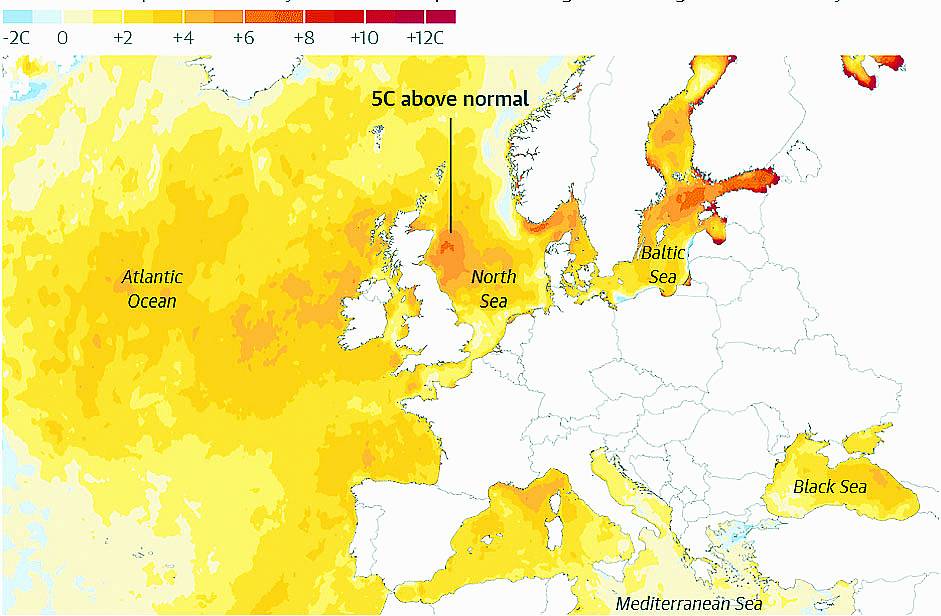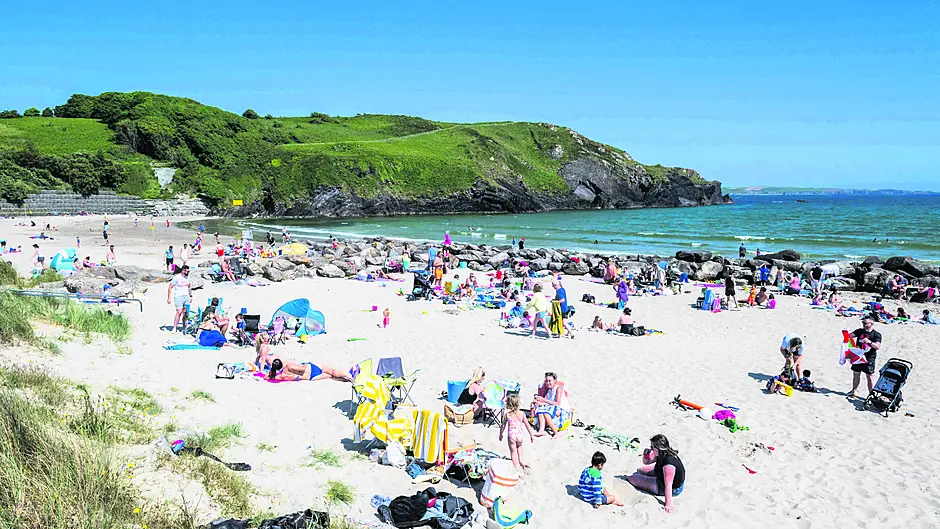Sea temperatures around West Cork have been several degrees above normal for this time of year. While sun lovers may be delighted, our marine life, and those dependent on it, should be worried, writes Vincent O’Shea
BEGINNING at the global level, latest reports from the World Meteorological Organization (WMO) highlight very high temperatures on both land and at sea.
Global-mean surface air temperatures for the first half of June 2023 were the highest by a considerable margin for the time of year, in the data record of the European Union’s Copernicus Climate Change Service (C3S). It also reported that the critical ‘1.5°C above pre-industrial levels’ was breached in early June. This comes after one of the warmest May’s on record.
Global sea surface temperatures (SST’s) hit a new high in May for the second consecutive month and in June were at unprecedented levels for the time of year, especially in the north Atlantic. Antarctic sea ice extent also reached a record low monthly value in May, the third time this year that happened. Its area shrunk by more than 15% compared to average over recent decades.
According to the WMO’s global climate observing system, the extraordinary sea surface temperatures have rung alarm bells.
Globally, sea surface temperatures are on average 0.2 degrees C warmer than at this time last year. This may not seem like much but given the oceans extent and water’s very high specific heat capacity, it represents a huge amount of extra heat energy absorbed and stored like a reservoir. This comes with a cost, including likely impacts on weather patterns, cyclone intensification and loss of biodiversity.
And all this comes as El Niño conditions are now starting to emerge across the equatorial Pacific and expected to gradually strengthen into Northern Hemisphere winter of 2023–24. WMO will provide an indication on its likely strength and duration, which has a warming impact on global temperatures, and influences rainfall patterns around the world.
 Sea temperature anomalies (differences from normal) in northeast Atlantic for June 2023 are showing several degrees above normal around Ireland and the UK. (Source: WMO)
Sea temperature anomalies (differences from normal) in northeast Atlantic for June 2023 are showing several degrees above normal around Ireland and the UK. (Source: WMO)
Moreover, signs that climate change (CC) is continuing are from increasing carbon dioxide (CO2) concentration levels – the heat trapping gases, reaching new worldwide records during May and June.
As we come closer to home, an almost ‘unheard of’ marine heatwave has been affecting Ireland during the late spring and early summer with sea surface temperatures several degrees above normal and smashing records.
For example, sea surface temperatures measured at the Met Eireann weather buoy (M3) positioned 40 nautical miles southwest of the Fastnet hit 18 degrees Celsius for much of June; that’s a full three to four degrees above the norm for the time of year.
Although the past week’s weather has been cooler and fresher, June 2023 had the highest air temperatures on record at 23 of 25 of the country’s stations, breaking a previous 83-year record set in 1940. A persistent onshore southeast breeze maintained the stations at Sherkin, Phoenix Park and Dublin Airport fresher, though they were still warmest since the notable June of 1976.
It is also remarkable that May was the second warmest on record, and every month of 2023 so far was above average. On top of this, half of the 10 warmest Junes on record have occurred since 2005. Judging by activities in West Cork so far this summer, it – along with the fine settled spell and high air temperatures – has been a welcome treat for many sunworshippers, beach walkers, boating/kayak enthusiasts, and swimmers. Around the coasts there were reports of water temperatures above 20 degrees measured on beaches such as Inchydoney, Tragumna and Barleycove.
This was most apparent in the shallow waters during afternoon flood tides. Lough Hyne saltwater lake exhibited temperatures even higher than the open sea. However, set against this are the stresses and threats to marine life caused by the human induced warming. This comes as a double whammy on the back of the emerging El Niño phenomenon. Marine biologists warn this could cause mortality in marine life including shellfish and, damage ecosystems if it continues.
At a local level we should be concerned about the impact on marine plants like seaweeds and kelp, losses in fisheries income and overall habitat loss. If we ignore cutting CO2 emissions, these land and maritime heatwaves may do further damage. Unfortunately, what happens on and below the surface of the ocean tends to go unnoticed.
At the time of writing, the extended outlook trend (from the C3S) taking us into August is for a continuation of above normal air temperatures, though overall sunshine and rainfall totals will be nearer the norm. Of course, this does not preclude more fine, warm sunny weather.
• Vincent O’Shea is a West Cork-based senior meteorologist with a specific interest in climate change.








